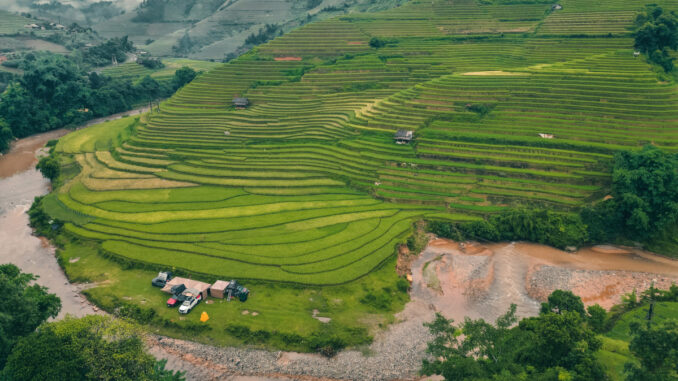
YEN BAI – During two days camping in Yen Bai, Mr. Minh admired the most beautiful scenery of the scenic terraced fields of Mu Cang Chai during the ripe rice season.

During the journey across Vietnam by car, Nguyen Ngoc Minh (28 years old, Soc Trang) with his wife and 18-month-old daughter camped at two locations in Mu Cang Chai to see terraced fields in the ripe rice season.
Mu Cang Chai is a district in the west of Yen Bai province, located at the foot of Hoang Lien Son mountain range, at an altitude of over 1,000m above sea level. The mountainous terrain is high and dangerous due to strong fragmentation, the average slope of the entire district is 40 degrees, in some places up to 70 degrees Celsius.

Terraced fields are a way for people to adapt to nature in steep mountainous terrain to create flat fields convenient for wet rice cultivation. Mu Cang Chai terraced fields are masterpieces created by nature and human hands over hundreds of years. In 2018, Mu Cang Chai terraced fields were included in the list of 12 most beautiful terraced fields in the world by the British newspaper Telegraph.
In 2019, the Mu Cang Chai terraced rice field landscape was ranked a special national monument by the Ministry of Culture, Sports and Tourism. Mu Cang Chai terraced fields are concentrated in La Pan Tan, Che Cu Nha and De Xu Phinh communes, with an area of about 330 hectares out of a total of 2,200 hectares across the district, according to the portal website of the Hanoi Department of Tourism. .

As a person who is passionate about experiencing and loves the Northwest roads, for Minh, Mu Cang Chai is one of the self-sufficient camping spots in the journey through Vietnam that he has planned. He came here in mid-September to admire the natural landscape of the Northwest, especially the ripe rice season.
Minh’s family’s first camping location was on the way to the top of Khau Pha pass, Mu Cang Chai town.

The camping area is an empty field of about 300 m2, located along the road to the pass, easy to find and convenient to move because the pass has been concreted and flat.
The camping location is about 1,000 meters above sea level, with a cliff on one side and an abyss on the other. From this height, visitors have a panoramic view to admire the terraced fields of Mu Cang Chai scenic spot. “Even when the rice is still green, the wide terraces of Mu Cang Chai still have a unique beauty,” Mr. Minh said.

Below the wooden railing is a garden of white and purple pink flowers planted by local people as a check-in point for tourists, creating a scene that is both majestic and poetic.
Mr. Minh noted that this area does not have establishments providing tourist services such as restaurants, motels, or tent rentals. Coming here, visitors should prepare enough food, drinks, and camping equipment.

On the second day, Mr. Minh’s family camped next to a stream in Che Cu Nha commune, about 30 km from Mu Cang Chai town. This location is not on Google Map, visitors move to Che Cu Nha commune then go down to town and ask local people for directions.

To get to the campsite, his family used a high-clearance car to wade across the stream. If riding a motorbike, visitors can park the bike at a local house and then bring camping gear across the stream to ensure safety, Mr. Minh suggested.

The camp site is a flat, empty field in front of the people’s terraced fields. Looking up from here, you can see green patches spreading evenly to the top of the hill in the distance. “The fresh air and quiet, cool space with the green of trees, mountains and forests help relax the mind, dispel the fatigue and sadness of everyday life,” he said.

When night falls, the space becomes quiet and cold. When he left, Mu Cang Chai was hot during the day but cold at night, the temperature could drop to about 15 – 17 degrees Celsius.
Therefore, the self-sufficient camping experience in Mu Cang Chai will only be suitable for those who have gone camping overnight and are equipped with specialized equipment such as tents mounted on the roof of the car, camping tables and chairs, cooking utensils, and cabinets. Portable refrigerator, electricity and domestic water storage tank. According to Mr. Minh, for tourists traveling by motorbike, two important and indispensable items are a tent and sleeping bag.
Currently in Mu Cang Chai, there are many camping tour organizers here, visitors can research and book tours to ensure safety and have the best experience.

Although terraced fields are densely covered around Mu Cang Chai town, tourists should go to Che Cu Nha. “This place has both streams and terraced fields along with majestic rolling hills and mountains,” Mr. Minh said. Among the places where his family used to camp overnight, this was one of the “most beautiful and romantic” places.

Rice here does not ripen evenly due to terrain, climate, and hydrology. Therefore, the rice ripening and harvesting time lasts for weeks, even months, giving visitors plenty of time to admire the golden autumn colors of the Northwest mountains and skies.
According to the website of the Vietnam National Tourism Administration, the best time to go to Mu Cang Chai to see ripe rice is around the end of September to October. This year, according to local people, around the end of October, the season Gold in Mu Cang Chai will end when people harvest all the rice.
Photo: internet
